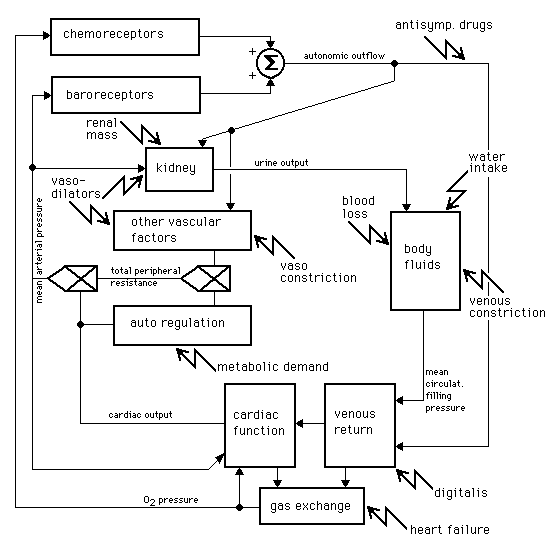
Model
The model of the computer simulation program CARDIO is based on a model of Coleman
(1980) of the cardiovascular system; of a healthy human being. It consists of
five compartments: the heart, the vascular system, the intra- and extracellular
fluid volumes, the nerve reflex system, and the kidney. The model contains a
number of relations between parameters in these compartments and consists of
about 60 variables.
Coleman's model of the blood pressure regulation and the cardiovascular system distinguishes three important regular quantities:
1. The extent of the vascular resistance is chiefly determined
by metabolic and neural factors. In this way it is possible to keep the circulation
of blood within the different tissues in the model as constant as possible (autoregulation)
while adapting to system needs. The preservation of the flow within a number
of tissues is one of the most important cardiovascular physiological priorities
of the intact organism.
2. The mean arterial pressure; is acutely regulated by the nerve reflexes, notably
the baroreceptor reflex (blood pressure regulation by the renin-angiotensin
system is not included in CARDIO). In the long run blood pressure is regulated
by the kidney function which controls the extracellular fluid volume.
3. The cardiac output is primarily determined by the venous return. Moreover the cardiac output can be directly influenced by the function of the heart as a pump.
Figure 9.1 The block diagram, also conceptual model, of the computer simulation program CARDIO. This model contains all the elements which play a role in regulating the blood pressure in a human body. The arrows indicate the intervention possibilities which the student can use for experiments.
Figure 9.1 contains a graph of the most important relations
in the model. The interventions which are possible in this model and their points
of application are mentioned in it. The most important variables of the model
and their normal values are:
Structure of the model
The model underlying the computer simulation program CARDIO was further developed
from Coleman's model and tested at the University of Limburg at Maastricht with
the RLCS system and later on at the University of Twente with the computer simulation
system MacTHESIS. The description of this model will be discussed relative to
Pascal notation and to analogue notation, as well as to the manner in which
these notations complement each other.
The heart
In the model the basic Cardiac Output (COB) -- i.e., the cardiac output without
the influence of the autonomic nerve system -- is a function of the right atrial
pressure (RAP). The cardiac output (CO) is determined by the basic cardiac output
(COB) and a heart function parameter (HF). This heart function (HF) is a function
of the right atrial pressure (RAP), the mean arterial pressure (AP), the sympathetic
nerve activity (AO), possible cardiac glycoside (DIGI), and the basal heart
strength (HSB).
The circulation
Many tissues in the body function optimally when the flow through the tissue
of the organ remains constant within certain limits. The regulating mechanism
that controls this tries to realize it through changes in the resistance. In
this model an attempt has been made to include an overall description of the
autoregulation phenomena. The mean arterial pressure is the product of the total
peripheral resistance and the cardiac output:
AP: = CO*TPR;
Intra- and extracellular fluid volume
The extracellular fluid volume (ECFV) is directly influenced by the fluid volumes
which are taken in by the body minus those which leave the body:
ECFV: = ECFV + (WIN - UO - BL)*dt;
In the model ECFV(0) = 15000 ml and the intake and output is 1 ml/min. The water
intake of the body (WIN) is set to 1 ml/min. The urine output (UO) is 1 ml/min
and the loss of blood (BL) is normally 0 ml/min.
The nerve reflex system
The autonomic nervous activity (AO), the value of which in the normal situation
is adjusted to 1, is dependent on the chemo and baroreceptor activity, a possible
adrenergic blockade (BLOCK), a possible pheochromocytoma (PHEO) -- which develops
an excessive sympathetic activity -- and a possible alpha-adrenergic influence
of norepinephrine (NOREPI).
The kidney
The kidney function depends on the composition of the blood, aldosterone, neuronal
factors, angiotensin, vasopressin, and the mean arterial pressure. In this model
the basic urine output (UOB), normally 1 (ml/min), is a function of the mean
arterial pressure (AP), the basal renal arterial resistance (RARB), the autonomic
output (AP), and a vasodilatation factor (DILAT).
The complete model written in Pascal is given by M?ller and Van Wijk van Brievingh
(in press). In their book an executable MS.DOS version of CARDIO has been enclosed.
Results (can be used in the exercise section)
The normal values for the mean arterial pressure (AP), the cardiac output (CO),
the total peripheral resistance (TPR), the urine output (UO) and the heart frequency
(HR) in the computer simulation program CARDIO, with the given aggressive values
and without any intervention are:
These 5 important hemodynamic variables can be supplemented
by the extracellular fluid volume (ECFV), the blood volume (BV), or the pressure
of the right atrium (RAP). These variables are normally not easy to measure.
In the exercises described here such variables play an important role. The computer
simulation program CARDIO not only gives visual feedback on the student interventions
but also textual feedback.
The following messages can appear on the screen when a particular variable reaches
above or below a certain limit:
